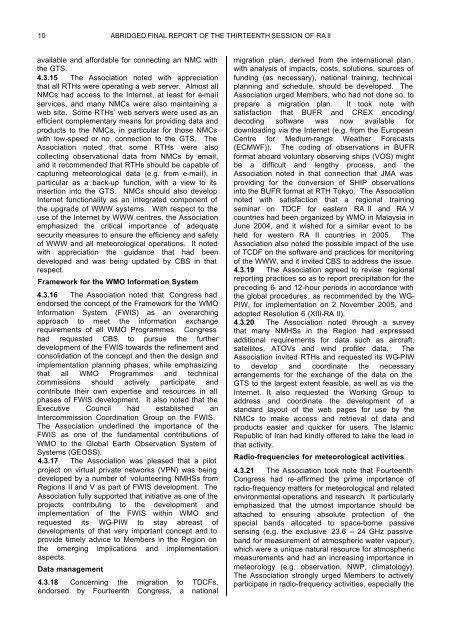Regional Association II (ASIA) - E-Library - WMO
Regional Association II (ASIA) - E-Library - WMO
Regional Association II (ASIA) - E-Library - WMO
Create successful ePaper yourself
Turn your PDF publications into a flip-book with our unique Google optimized e-Paper software.
10 ABRIDGED FINAL REPORT OF THE THIRTEENTH SESSION OF RA <strong>II</strong>available and affordable for connecting an NMC withthe GTS.4.3.15 The <strong>Association</strong> noted with appreciationthat all RTHs were operating a web server. Almost allNMCs had access to the Internet, at least for e-mailservices, and many NMCs were also maintaining aweb site. Some RTHs’ web servers were used as anefficient complementary means for providing data andproducts to the NMCs, in particular for those NMCswith low-speed or no connection to the GTS. The<strong>Association</strong> noted that some RTHs were alsocollecting observational data from NMCs by e-mail,and it recommended that RTHs should be capable ofcapturing meteorological data (e.g. from e-mail), inparticular as a back-up function, with a view to itsinsertion into the GTS. NMCs should also developInternet functionality as an integrated component ofthe upgrade of WWW systems. With respect to theuse of the Internet by WWW centres, the <strong>Association</strong>emphasized the critical importance of adequatesecurity measures to ensure the efficiency and safetyof WWW and all meteorological operations. It notedwith appreciation the guidance that had beendeveloped and was being updated by CBS in thatrespect.Framework for the <strong>WMO</strong> Information System4.3.16 The <strong>Association</strong> noted that Congress hadendorsed the concept of the Framework for the <strong>WMO</strong>Information System (FWIS) as an overarchingapproach to meet the information exchangerequirements of all <strong>WMO</strong> Programmes. Congresshad requested CBS to pursue the furtherdevelopment of the FWIS towards the refinement andconsolidation of the concept and then the design andimplementation planning phases, while emphasizingthat all <strong>WMO</strong> Programmes and technicalcommissions should actively participate andcontribute their own expertise and resources in allphases of FWIS development. It also noted that theExecutive Council had established anIntercommission Coordination Group on the FWIS.The <strong>Association</strong> underlined the importance of theFWIS as one of the fundamental contributions of<strong>WMO</strong> to the Global Earth Observation System ofSystems (GEOSS).4.3.17 The <strong>Association</strong> was pleased that a pilotproject on virtual private networks (VPN) was beingdeveloped by a number of volunteering NMHSs fromRegions <strong>II</strong> and V as part of FWIS development. The<strong>Association</strong> fully supported that initiative as one of theprojects contributing to the development andimplementation of the FWIS within <strong>WMO</strong> andrequested its WG-PIW to stay abreast ofdevelopments of that very important concept and toprovide timely advice to Members in the Region onthe emerging implications and implementationaspects.Data management4.3.18 Concerning the migration to TDCFs,endorsed by Fourteenth Congress, a nationalmigration plan, derived from the international plan,with analysis of impacts, costs, solutions, sources offunding (as necessary), national training, technicalplanning and schedule, should be developed. The<strong>Association</strong> urged Members, who had not done so, toprepare a migration plan. It took note withsatisfaction that BUFR and CREX encoding/decoding software was now available fordownloading via the Internet (e.g. from the EuropeanCentre for Medium-range Weather Forecasts(ECMWF)). The coding of observations in BUFRformat aboard voluntary observing ships (VOS) mightbe a difficult and lengthy process, and the<strong>Association</strong> noted in that connection that JMA wasproviding for the conversion of SHIP observationsinto the BUFR format at RTH Tokyo. The <strong>Association</strong>noted with satisfaction that a regional trainingseminar on TDCF for eastern RA <strong>II</strong> and RA Vcountries had been organized by <strong>WMO</strong> in Malaysia inJune 2004, and it wished for a similar event to beheld for western RA <strong>II</strong> countries in 2005. The<strong>Association</strong> also noted the possible impact of the useof TCDF on the software and practices for monitoringof the WWW, and it invited CBS to address the issue.4.3.19 The <strong>Association</strong> agreed to revise regionalreporting practices so as to report precipitation for thepreceding 6- and 12-hour periods in accordance withthe global procedures, as recommended by the WG-PIW, for implementation on 2 November 2005, andadopted Resolution 6 (X<strong>II</strong>I-RA <strong>II</strong>).4.3.20 The <strong>Association</strong> noted through a surveythat many NMHSs in the Region had expressedadditional requirements for data such as aircraft,satellites, ATOVs and wind profiler data. The<strong>Association</strong> invited RTHs and requested its WG-PIWto develop and coordinate the necessaryarrangements for the exchange of the data on theGTS to the largest extent feasible, as well as via theInternet. It also requested the Working Group toaddress and coordinate the development of astandard layout of the web pages for use by theNMCs to make access and retrieval of data andproducts easier and quicker for users. The IslamicRepublic of Iran had kindly offered to take the lead inthat activity.Radio-frequencies for meteorological activities4.3.21 The <strong>Association</strong> took note that FourteenthCongress had re-affirmed the prime importance ofradio-frequency matters for meteorological and relatedenvironmental operations and research. It particularlyemphasized that the utmost importance should beattached to ensuring absolute protection of thespecial bands allocated to space-borne passivesensing (e.g. the exclusive 23.6 – 24 GHz passiveband for measurement of atmospheric water vapour),which were a unique natural resource for atmosphericmeasurements and had an increasing importance inmeteorology (e.g. observation, NWP, climatology).The <strong>Association</strong> strongly urged Members to activelyparticipate in radio-frequency activities, especially the
















